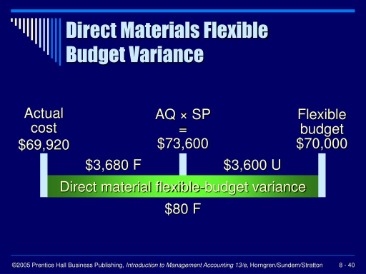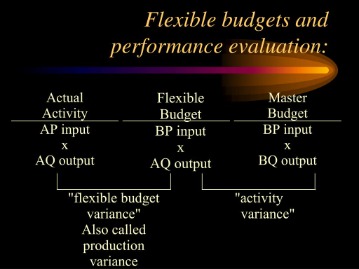Content
- Direct Materials Quantity Variance Calculation
- Best Practices For Budgeting In Quickbooks
- Insert Totals And Subtotal Formulas
- What Is The Difference Between Net Sales & Net Income?
- Create Variance Tab And Calculate Variances
The department’s total flexible budget variance is $4,000 favorable since the actual expenses of $508,000 were less than the flexible budget of $512,000. First, a flexible budget is a budget in which some amounts will increase or decrease when the level of activity changes.

Flexible budget variances are simply the differences between line items on actual financial statements with those on flexed budgets. Since the actual activity level is not available before the accounting periods closes, flexed budgets can only be prepared at the end of the period. Flexible budgeting performance report analyzes actual results against the standard budgets.
Direct Materials Quantity Variance Calculation
Integrating cash flow forecasts with real-time data and up-to-date budgets is a powerful tool that makes forecasting cash easier, more efficient, and shifts the focus to cash analytics. Here you will enter the budget forecast amount for the specified time period. Be sure to make your labels for each budget category easy to reference from raw data. Production volume variance measures overhead cost per unit of actual production against the expectations reflected in a business’s budget. Cost accounting is a form of managerial accounting that aims to capture a company’s total cost of production by assessing its variable and fixed costs.A flexible budgeting approach is more realistic and practical than a static budget. You should perform a flexible budgeting variance analysis for each activity to gain valuable information on discrepancies in planning and operations. Static budgets don’t allow for making changes in the variables based on a change in activity level. If a business changes its production level, its variable cost will change as well. Static budgets don’t consider the changes that result in a change in the sales or production level. The static budget approach monitors planned and actual results with a focus on achieving a set target. An understanding of how a company’s revenue and costs are affected when activity changes within a specific time period is required to prepare a flexible budget based on a master budget.A flexible budget variance is the difference between 1) an actual amount, and 2) the amount allowed by the flexible budget. This will help provide context to yourself or the end-user by providing information on the budget period. It can also be used to show which location or department the budget, forecast, and variance analysis is for. If it is for a top-level budget variance report, then you can simply show that rather than displaying a location or department. The materials quantity variance calculation presented previously shows the actual quantity used in production of 399,000 pounds is lower than the expected quantity of 420,000 pounds. Clearly, this is favorable because the actual quantity used was lower than the expected quantity. The standard quantity of 420,000 pounds is the quantity of materials allowed given actual production.Using the variance formula and presenting this type of information is critical in FP&A. In the following paragraphs, we will break down each of the formulas in more detail. (FP&A) to help evaluate results and make informed decisions for a business going forward. The offers that appear in this table are from partnerships from which Investopedia receives compensation.
Best Practices For Budgeting In Quickbooks
Suggest several possible reasons for the materials price and quantity variances. In the first six months of 2004, steel prices increased 76 percent, from $350 a ton to $617 a ton. For auto suppliers that use hundreds of tons of steel each year, this had the unexpected effect of increasing expenses and reducing profits. For example, a major producer of automotive wheels had to reduce its annual earnings forecast by $10,000,000 to $15,000,000 as a result of the increase in steel prices. An unfavorable, or negative, budget variance is indicative of a budget shortfall, which may occur because revenues miss or costs come in higher than anticipated. New flexible budgeting provides greater advantages compared to static budgets, there are some limits involved as well. Let’s say Green Company estimates their total production capacity to be 250,000 units.If the company finds that its actual expense to produce the 12,000 units was $75,000, there is a $15,000 spending variance. It could represent a cost overrun or it could be due to a variable cost that was estimated as fixed. This is an unfavorable variance because the actual cost is greater than expected at the actual activity level.
- The flexible budget formula provides a way to compute expected costs at different levels of activity in order to make meaningful comparisons.
- A favorable budget variance refers to positive variances or gains; an unfavorable budget variance describes negative variance, indicating losses or shortfalls.
- The difference between actual costs for materials purchased and budgeted costs based on the standards.
- If the variances are considered material, they will be investigated to determine the cause.
- Management may also adjust sales prices to achieve the favorable variance as long as it doesn’t affect their competitive edge.
- It stands for vertical lookup and it searches for a specified value in a column and returns a corresponding value from a different column in the same row.
- Harold Averkamp has worked as a university accounting instructor, accountant, and consultant for more than 25 years.
For Jerry’s Ice Cream, the standard quantity of materials per unit of production is 2 pounds per unit. Thus the standard quantity of 420,000 pounds is 2 pounds per unit × 210,000 units produced and sold. Note that both approaches—the direct materials price variance calculation and the alternative calculation—yield the same result.
Insert Totals And Subtotal Formulas
Management may decide to increase or decrease production levels depending on sales targets and a variety of other factors. At that point, the static budget acts as a starting point for the flexible budgeting approach. The revised budget can be compared with actual results to analyze realistic variances. While advancements in data collection and management have made utilizing raw data easier, the vast majority of businesses continue to rely on excel based financial models and reporting.
What is the formula of material price variance?
Vmp = (Actual Quantity Purchased * Actual Unit Cost) – (Actual Quantity Purchased * Standard Unit Cost). When the Actual Materials Price is higher than the Standard Materials Price, the variance is said to be unfavorable, since the Actual price paid on materials purchased is greater than the allowed standard.From this understanding, formulas are created that capture cost and revenue behavior in the master budget. Before costs can be added in, they should be classified correctly as variable or fixed. As an example, take a company with a master budget that projects production of 10,000 units. It turns out that 2,000 more units were produced than expected, for an actual total of 12,000 units. That number can be plugged into a flexible budget formula to make adjustments to the forecasts for sales and revenue due to the change in volume.
What Is The Difference Between Net Sales & Net Income?
The difference between actual costs for materials purchased and budgeted costs based on the standards. The fixed costs are constant and remain same in both static and flexed budgets. The next step is to subtract flexible budget amounts from actual figures to obtain the required variances.

If the company performs well and reaches an above-target performance, it will have a favorable variance of $90,625. The activities that could cause flexible budgets to flex might be the amount of sales, units of output, machine hours, miles traveled, etc. In the cells use the below formula to automatically calculate variances as actual data becomes available. GR Spring and Stamping, Inc., a supplier of stampings to automotive companies, was generating pretax profit margins of about 3 percent prior to the increase in steel prices.
Flexible Budget Variance
Companies using a standard cost system ultimately credit favorable variances and debit unfavorable variances to income statement accounts. The appendix to this chapter describes this process in further detail. For instance, assuming production is cut, variable costs are also going to be lower. Under a flexible budget, this is reflected, and results can be evaluated at this lower level of production. Under a static budget, the original level of production stays the same, and the resulting variance is not as revealing.If you have a positive variance, the company produced favorable results and achieved more than it had originally planned. And adverse or negative variance means the organization was not able to achieve its target plans. Because the budget can be made for any activity, the variance also needs to be analyzed separately for each activity.The direct material and labor costs per unit are $4.50 and $2.50 respectively. The company offers sales incentives to their sales force of 5% of sales. Every finance department knows how tedious building a budget and forecast can be.A flexible budget allows for changes and updates to be made when assumptions used to devise the budget are altered. A static budget remains the same, however, even if the assumptions change. The flexible budget thus allows for greater adaptability to changing circumstances and should result in less of a budget variance, both positive and negative. The initial estimate or static budget is a necessary part of planning. Creating a second, flexible budget allows a company to evaluate its actual performance during the static budget period. Notice how the cause of one variance might influence another variance. This also might have a positive impact on direct labor, as less time will be spent dealing with materials waste.